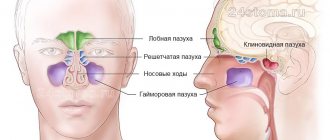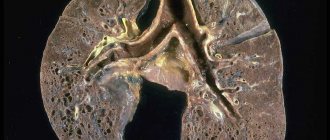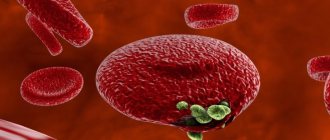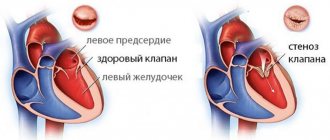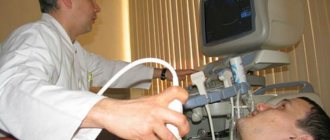One type of upper respiratory tract disease, sphenoiditis, occurs less frequently than other forms of sinusitis. But this disease belongs to the category of the most dangerous, fraught with serious complications. With sphenoiditis, inflammation occurs in the mucous membrane of one of the paranasal sinuses (sinus), located deep in the skull. The sphenoid sinus is located in close proximity to the carotid arteries, optic nerves, pituitary gland and other anatomical structures important for the normal functioning of the human body. To avoid complications, sphenoiditis must be treated in a timely manner.
Sphenoiditis: symptoms and treatment
Inflammation of the sphenoid paranasal sinus is divided into two main forms: acute and chronic.
The acute period is accompanied by constant nasal congestion. The following manifestations are also characteristic of this stage:
- Regular mucous discharge, clear or purulent. If the sinus outlet is blocked, fluid may not flow out. In this case, the patient experiences tolerable headaches, which cannot be reduced even with the help of potent analgesics.
- Pain in the occipital region, especially intense in the morning.
- Increased body temperature to 38 degrees or higher, general weakness and other symptoms of intoxication.
During the initial examination, a therapist or otolaryngologist may only detect redness and swelling of the nasal passages. Minor or copious purulent discharge is often observed.
With a sluggish form of inflammation of the sphenoid sinus, pronounced symptoms can appear only during exacerbation. But unlike chronic adenoiditis and other types of inflammatory diseases of the nasopharynx, sluggish sphenoiditis is characterized by unexpressed pain or discomfort in the occipital area.
1.General information
In the skull of an adult there are four groups of air-filled cavities - the paranasal sinuses (paranasal sinuses, paranasal sinuses), - covered from the inside with a mucous membrane of ciliated epithelium and opening through narrow anastomoses into the nasal cavity. Inflammatory processes in the paranasal sinuses are called sinusitis. There are four local variants, based on the number of sinuses: sinusitis if the maxillary (maxillary) sinuses are affected, frontal sinusitis with inflammation in the frontal sinuses, ethmoiditis with inflammation of the sinuses of the ethmoidal labyrinth and sphenoiditis if the inflammation is localized in the sinus of the sphenoid bone.
The sphenoid bone is located in the conventional geometric center of the skull, i.e. its air sinus (occupying most of the bone volume) is the least accessible for intravital study and clinical diagnosis. The sphenoid sinus is usually described as a single unpaired sinus, with sphenoiditis as the rarest variant. However, both theses require comments.
The fact is that the air sinus of the sphenoid bone is nevertheless divided by a septum into two separate sinuses, in most cases asymmetrical.
In general, the structure of this bone structure (and, accordingly, the sinus) is very variable, i.e. In different people, the sphenoid bone can vary significantly in shape and size. In addition, the specialized literature and periodicals emphasize that the sphenoid paranasal sinus is the least studied, both normally and in pathology. This also applies to epidemiological assessments.
The prevalence of sinusitis today is estimated at 5-15% in the general population, with sinusitis and frontal sinusitis leading, and the share of sphenoiditis in the volume of registered rhinosinusitis does not exceed 5%; Often this variant of “posterior” sinusitis is not mentioned at all in medical reports. The number of publications on this topic is small, and not only in domestic but also in world otorhinolaryngology there is a clear shortage of large generalizing works based on the analysis of large arrays of empirical observations (in particular, computed tomography). At the same time, the results of post-mortem pathomorphological studies are presented, according to which signs of an inflammatory process in the sinus of the sphenoid bone are found in at least every tenth case (10%). In other words, there is reason to believe that the generally accepted view of sphenoiditis as a rare and least common variant of sinusitis is most likely erroneous, and estimates of the incidence are underestimated by times, if not orders of magnitude.
A statistical relationship between incidence and gender has not been established: the probability of detecting sphenoiditis is approximately the same for men and women. The dependence on age (at least linearly) is also not visible, but it is known that up to 80% of all inpatients with rhinosinusitis are under the age of 50 years. It is also known that inflammation in the area of the sinus of the sphenoid bone is associated, especially in children of the first three to five years of life, with a high risk of severe complications, and this problem has also been insufficiently studied.
A must read! Help with treatment and hospitalization!
Causes of sphenoiditis
The cause of inflammation of the sphenoid sinus is infection with viruses, fungi and pathogenic bacteria.
In the acute form, the causative agents are certain types of bacteria and viruses (adenoviruses, rhinoviruses, influenza virus). Chronic sphenoiditis is caused by fungi and bacteria: Proteus, Pseudomonas aeruginosa, Haemophilus influenzae, Escherichia coli, Candida and others.
In most cases, sphenoiditis develops against the background of the following provoking factors:
- Small volumes of the sphenoid sinus (or one of its sections), the presence of tumor, cystic, and polypous formations.
- Foreign objects entering the sinus, which is possible with increased sizes of the outlet openings.
- Deviation of the nasal septum.
- Unnatural additional partitions in the sinus that interfere with the normal outflow of secretions.
Diagnostics
Due to the deep location of the sphenoid sinus, the disease is difficult to diagnose in time. Its proximity to the trigeminal, optic and other nerves creates a danger for the development of neurological disorders, which in some cases are a clear and only marker of ENT pathology. When making a diagnosis, along with the patient’s complaints, data from endoscopy, computed tomography and magnetic resonance imaging are taken into account. For diagnostic purposes, puncture of the affected sinus can also be performed.
Treatment of inflammation of the sphenoid sinus
Treatment of the acute form of sphenoiditis in most cases does not require much time if you consult a doctor in a timely manner. Usually it is enough to take antibiotics prescribed by a doctor and vasoconstrictors for the nasal cavity (sprays, drops). Sometimes an otolaryngologist may prescribe additional physiotherapeutic procedures, for example, ultra-high frequency (UHF).
Treatment of chronic sphenoiditis is not limited solely to medication and physiotherapeutic methods. In some cases, surgery is required. Today, endoscopes are used for these purposes, with the help of which it is possible to penetrate the sphenoid sinus without extensive interventions, expand the inlet, remove polyps, correct the shape of the nasal septum and perform a host of other related manipulations.
The following agents can be used as auxiliary agents that accelerate the removal of purulent secretions and relieve swelling of the mucous membranes of the upper respiratory tract:
- Essential oils (camphor, menthol, eucalyptus) - 1 drop in each nostril.
- Irrigation-elimination therapy: sea water preparations, for example, Aqualor. Rinse the nasopharynx several times a day.
4.Treatment
Therapy for sphenoiditis, in fact, should begin with the maximum possible elimination of all anatomical (deformation, hyperplasia, etc.), infectious and environmental factors that create the ground for the progression or recurrence of sphenoiditis. The most important task is to restore ventilation and drainage of the sphenoid sinuses. For this purpose, vasoconstrictor drugs are prescribed, and antibiotic, antiviral, and antimycotic regimens are used as etiotropic therapy (depending on the examination results).
As necessary, resort to symptomatic drugs: NSAIDs, analgesics, vitamins, probiotics, antipyretics.
In cases where conservative intervention is ineffective or the clinical situation quickly worsens, surgical intervention is performed; If there is a choice and opportunity, they prefer minimally invasive endoscopic surgery.
Treatment of sinusitis at MedicCity
Conservative methods of treating sinusitis
If you are concerned about how to treat sinusitis in Moscow, be sure to contact the MedicCity specialists! Our clinic provides treatment for sinusitis without puncture and without pain. However, non-surgical treatment of sinusitis is possible only at the initial stage. Don't waste time!
In the vast majority of cases, treatment of sinusitis in our clinic is carried out without a puncture.
- Using YAMIK (sinus catheter). The YAMIK method is the use of a device called the “YAMIK sinus catheter.” Using the YAMIK sinus catheter, controlled pressure is created in the nasal cavity and the purulent contents of the sinus are pumped out through the natural anastomosis (openings), and then a medicinal substance (antibiotics, mucolytics) is administered.
- Rinsing the nose and paranasal sinuses using the moving method (“cuckoo”). It is carried out using a special suction - an aspirator; in the process, pathological contents are removed from the nasal cavity and sinuses and the drug is injected into the sinuses.
- Inhalation therapy using a special inhaler PARI SINUS. This method is based on the introduction of microparticles of the drug into the affected paranasal sinuses through a pulsating supply of an aerosol. In this case, the aerosol of the medicinal substance is deposited in the sinuses and has an effect directly at the site of inflammation.
All proposed methods for treating sinusitis are painless and effective.
When using combined treatment, complete recovery in case of acute sinusitis is achieved within 7-10 days.
If puncture treatment is necessary, it is possible to install special catheters in the sinus, which eliminate the need for repeated punctures.
Prevention
The most important thing in preventing sphenoiditis is strengthening the immune system. It is because of weakened immunity that sphenoiditis develops - the body simply cannot fight pathogenic microflora and infections. To strengthen the body's defenses, it is necessary to develop resistance to stress. It is also important to follow a daily routine, eat right, and lead a healthy lifestyle. Hardening will also be beneficial, but it must be carried out strictly according to the rules.
How to make an appointment with the specialists of JSC "Medicine" (clinic of academician Roitberg)
You can make an appointment with the specialists of JSC "Medicine" (clinic of Academician Roitberg) on the website - the interactive form allows you to select a doctor by specialization or search for an employee of any department by name and surname. Each doctor’s schedule contains information about visiting days and hours available for patient visits.
Clinic administrators are ready to accept requests for an appointment or call a doctor at home by calling +7 (495) 775-73-60.
Convenient location on the territory of the central administrative district of Moscow (CAO) - 2nd Tverskoy-Yamskaya lane, building 10 - allows you to quickly reach the clinic from the Mayakovskaya, Novoslobodskaya, Tverskaya, Chekhovskaya and Belorusskaya metro stations .
Wedge in the nose
According to medical definitions, sphenoiditis has several names. “In general, when they talk about sphenoiditis, they mean the sphenoid sinus. There are several concepts in medicine of the same anatomical formation - main sinus, sphenoidal sinus, sphenoid sinus. It is called the main one because it is actually located at the base of the skull, as deep as possible in the center. Wedge-shaped - because it has a characteristic shape. If in Latin, then we are talking about the sphenoidal sinus. But all this is essentially the same thing,” says Vladimir Zaitsev.
Article on the topic Drops or spray? What's better for a runny nose?
As the ENT doctor notes, sphenoiditis in terms of frequency of manifestations is the rarest variant among sinusitis. According to statistics, it occurs in 3-5% of cases. At the same time, it is necessary to understand that it cannot be underestimated, since its consequences are extremely negative. “Such inflammation begins in a standard way: first, inflammation of the nasal cavity occurs when an infection occurs, usually presenting as a picture of acute rhinitis, then the infection and inflammation go not to the maxillary sinus, but to the sphenoidal sinus. As a rule, this occurs if the anastomosis connecting the sinus and nasal cavity is open. As a result, the infection gets there and leads to the development of inflammation,” explains the otolaryngologist.
A similar situation can develop when a person rinses his nose incorrectly. For example, if he puts too much pressure on the bottle, pressure builds up and everything ends up in the wrong place. “Or there may be a condition when a person simply decided to rinse his nose preventively, that is, there is nothing to rinse, but he still wants to wash it. Here it is important to understand that the anastomosis is in the state of a valve, when it can pass the solution through itself, it passes into the sinuses, but the solution cannot come back out,” says Zaitsev.
The situation is worsened when the sinus is severely inflamed and the person presses too hard on the bottle dispenser. The anastomosis does not work well here; the solution remains behind the anastomosis and causes severe inflammation.
When everything is in our hands. What diseases can a runny nose be a symptom of? More details
Sinusitis in children
Sometimes sinusitis in children is more difficult to see than sinusitis in adults. The disease usually develops after an infection: influenza or sore throat, and is often accompanied by otitis media. The symptoms are somewhat blurred and appear weaker than in adults. Here are the main ones:
- purulent or mucous discharge from the nose;
- general weakness, malaise;
- pungent odor from the mouth.
With sinusitis in children, one side of the face is often inflamed. While sinusitis in adults is often accompanied by headaches, headaches in children are extremely rare.
Routes of infection
The sphenoid sinuses belong to the group of paranasal sinuses, but they are deeper than the others. The name comes from the fact that they are located deep in the sphenoid bone. Inflammatory processes in this place occur due to the fact that respiratory infections penetrate there through the cells of the ethmoid labyrinth from other sinuses. Most often they come from the frontal or maxillary. The infection can also spread from the pharynx, the nasal cavity itself. Very often, the infection spreads from the tonsils of the nasopharynx.
Sphenoiditis is a consequence of influenza, scarlet fever, sore throat or even ordinary rhinitis; it usually develops as a complication of these diseases. If there are no such diseases, then in other cases the risk of developing sphenoiditis is extremely small, since the infection penetrates into the sphenoid sinuses, causing inflammatory processes of low intensity, after which they quickly pass. So you can only get infected with sphenoiditis from people who have a sore throat, flu, scarlet fever or a common cold, but at the same time the person must also develop similar diseases, and then develop a complication in the form of sphenoiditis.
How does a doctor diagnose sphenoiditis?
The ENT doctor, after a preliminary examination and interview with the patient, conducts a clinical examination using nasal endoscopy. Using endoscopy, you can detect inflammatory (purulent) foci in the paranasal sinuses.
This so-called "endoscopy" is not painful, but may be uncomfortable. To avoid this, the nasal cavity is pre-treated with a local anesthetic.
To diagnose sphenoiditis, it is necessary to perform a computed tomography (CT) scan of the sinuses.
Sign up for a consultation
What is acute sphenoiditis?
Paranasal sinuses are air-filled structures in the skull that are connected by narrow passages to the nasal cavity.
These include the maxillary, emoidal, frontal and sphenoidal sinuses. They are much less likely to become inflamed than, for example, the maxillary (maxillary) sinus. However, sphenoiditis is quite susceptible to the chronic course of the disease. In the paranasal sinuses, secretions and mucus are formed, which normally flow through the anastomosis into the nasal cavity. However, if these passages become clogged with swelling of the mucous membrane from a cold or other reasons, then the outflow of discharge is disrupted. There is then a risk of bacterial or viral infection accumulating in the sinuses.
In 90% of cases, sphenoiditis is viral (flu, acute respiratory infections, etc.) and only as the disease continues does bacteria join this process (bacterial superinfection).
